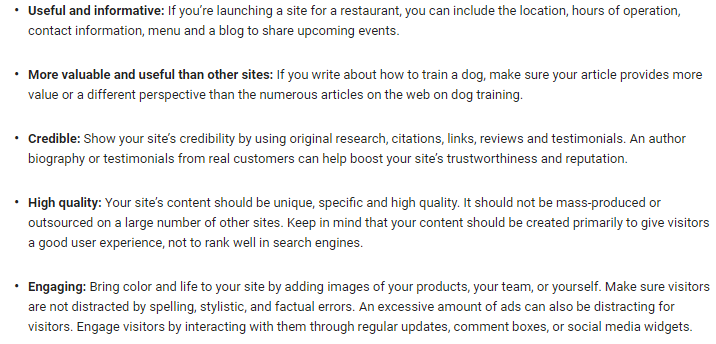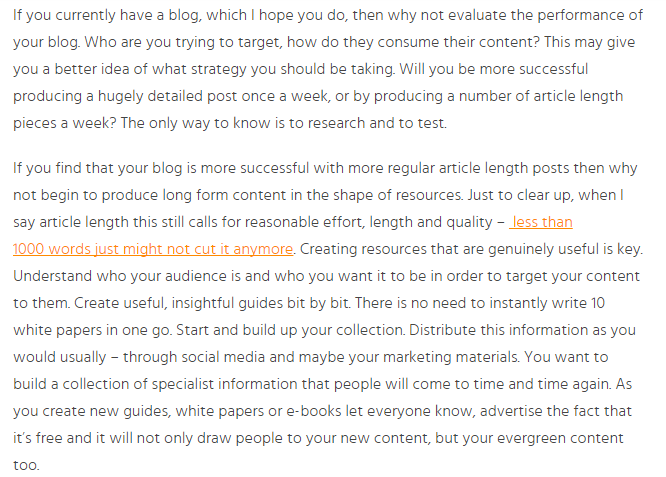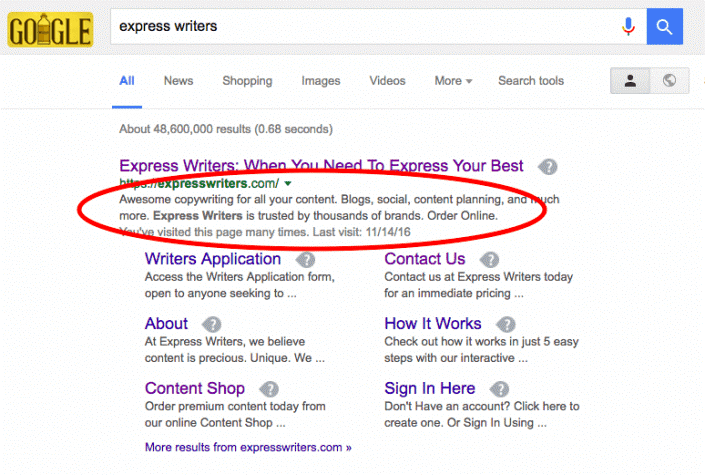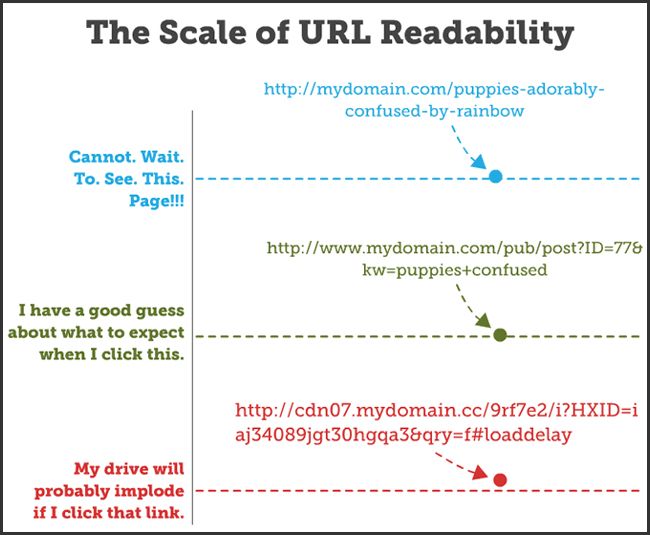SEO
Why Content Is Important for SEO

At their best, they form a bond that can catapult any website to the top of search engine rankings.
But that’s only when they’re at their best. Because, when they’re at their worst, they can cause Google penalties that are near impossible to recover from.
The purpose of this chapter is simple; to provide you with an understanding of why content is important for SEO and show you what you can do to make sure they work together in harmony.
As we dive in, we’ll gain a better understanding of what content means, what its SEO value is, and how to go about creating optimized content that lands you on the search engine radar.
Let’s get started.
What ‘Content’ Means
Providing an exact definition for content, and one that is agreed upon by all marketers would be near impossible.
But, while it is a challenge, TopRank Marketing CEO Lee Odden gathered some definitions of content from marketers around the world that give us a solid starting point.
Actionable marketer Heidi Cohen describes content as:
“High quality, useful information that conveys a story presented in a contextually relevant manner with the goal of soliciting an emotion or engagement. Delivered live or asynchronously, content can be expressed using a variety of formats including text, images, video, audio, and/or presentations.”
While Cohen’s description is right on point, it’s important to understand that content found online isn’t always high quality and useful.
There’s a lot of bad content out there that doesn’t come close to providing any type of relevancy or usefulness to the reader.
In a more simplified but similar definition, Social Triggers founder Derek Halpern says:
“Content comes in any form (audio, text, video), and it informs, entertains, enlightens, or teaches the people who consume it.”
Once again, Halpern is describing content that is, at the very least, relevant and useful to its intended audience.
If we avoid a description of “quality” content, we can take a more direct approach by looking at the dozens of different types of digital content.
At this point, you should have a pretty good idea of what content is while also understanding some of the different formats where it can be presented.
But what exactly is its value to SEO, and why is it so important that the two work together?
What Is the SEO Value of Content?
Google, the king of search engines, processes over 6.7 billion searches per day.
And since we’re talking about search engine optimization, that means they’re pretty well suited to answer this question.
Larry Page and Sergey Brin co-founded Google in 1998 with a mission:

That mission remains the same today. The way in which they organize that information, however, has changed quite a bit over the years.
Google’s algorithms are constantly evolving in an effort to deliver, as they say, “…useful and relevant results in a fraction of a second.”
The “useful and relevant results” that Google is attempting to deliver are the pieces of content that are available throughout the web.
These pieces of content are ranked by their order of usefulness and relevancy to the user performing the search.
And that means, in order for your content to have any SEO value at all, it needs to be beneficial to searchers.
How do you make sure it’s beneficial? Google helps us with that answer too.
Their recommendation is that, as you begin creating content, make sure it’s:

When these elements are in place, you maximize the potential of the SEO value of your content. Without them, however, your content will have very little value.
But, creating great content isn’t the only piece of the puzzle. There’s a technical side that you need to be aware of as well.
While we’ll talk about that later in this chapter, Maddy Osman put together a comprehensive resource on How to Evaluate the SEO Value of a Piece of Content that further elaborates on the topic.
For now, we can conclude that the SEO value of content depends on how useful, informative, valuable, credible, and engaging it is.
The Importance of Optimizing Content
The reason optimized content is important is simple… you won’t rank in search engines without it.
But, as we’ve already touched on briefly, it’s important to understand that there are multiple factors at play here.
On one side, you have content creation.
Optimizing content during creation is done by ensuring that your content is audience-centric and follows the recommendations laid out in the previous section.
But what does audience-centric mean, and how does it differ from other types of content?
Audience-centric simply means that you’re focusing on what audiences want to hear rather than what you want to talk about.
And, as we’ve identified, producing useful and relevant content is the name of the game if you’re looking to rank in search engines.
On the other side of the optimization equation is the technical stuff.
This involves factors like keywords, meta titles, meta descriptions, and URLs.
And that’s what we’re going to talk about next as we dive into how to actually create optimized content.
How to Create Optimized Content
When attempting to create optimized content, there are a few steps that we need to follow.
They include:
1. Perform Keyword Research & Determine Your Topic
While we’ve already identified that your main goal should be to create audience-centric content, keyword research is necessary to ensure that the resulting content can be found through search engines.
A few things to keep in mind when choosing your keywords and topic:
- Focus on Long-Tail Keywords
- Avoid Highly Competitive Keywords With Massive Search Numbers
- Use a Proven Keyword Research Tool
- Match Your Topic to Your Keyword
2. Develop Your Outline & Format for Optimal Readability
As you’re creating your outline, be sure that you’re formatting your core content so that it’s broken down into small chunks.
Online readers have incredibly short attention spans. And they’re not going to stick around if your article is just one ginormous paragraph.
It’s best to stick with paragraphs that are 1-2 sentences in length, although it’s all right if they stretch to 3-4 shorter sentences.
You’ll also want to be sure that you’re inserting sub-headers and/or visuals every 150-300 words to break up the content even further.
As you can see from the graph below, website engagement impacts organic rankings.

And, if you want to increase engagement, readability is crucial.
Example of Properly Formatted Content
Here’s an example of a page that is formatted for optimal readability:

As you can see, most of the paragraphs are only a sentence or two long.
The text is also broken up using subheadings every 100-200 words.
Example of Poorly Formatted Content
On the other end of the spectrum, here’s an example of a post that’s likely to send readers away directly:

In this post, the content itself is fine. The problem is the extremely long sentences and paragraphs.
With better formatting, the author could easily increase visitors’ average time on site.
3. Stick to Your Topic & Target Keyword
As you begin writing your content, keep in mind the importance of sticking to the topic, and target keyword that you’ve chosen.
Don’t try to write about everything and anything within a single piece of content. And don’t try to target dozens of keywords.
Doing so is not only a huge waste of time, but it also prevents you from creating the most “useful and relevant” content on your topic.
Focus on what you’ve chosen as your topic and stay hyper-relevant to that topic and the keyword that supports it.
Brian Harnish’s Local SEO Guide for Beginners is a great example of an author staying hyper-relevant to a specific topic and keyword.
Just by looking at his title, the topic and target keyword are immediately clear.
And, due to this focus, Harnish’s guide ranks on the first page of Google for the phrase ‘local SEO guide.’

4. Include Backlinks Throughout Your Content
If you read the local SEO guide, you’ll notice that Harnish includes several links to external sites.
Since Google has made it clear that credibility is an important SEO factor, linking to relevant, trustworthy, and authoritative sites can help ensure that search engines see your content as credible.
Be sure, however, that the words you’re using for the link are actually relevant to the site the user will be sent to.
For example, take a look at this sentence:
“You need to understand how to create a compelling headline for your content.”
If you were to link to a resource showing the reader how to create compelling headlines, you’d want to link the bolded portion shown below:
“You need to understand how to create a compelling headline for your content.”
In most cases, it’s recommended that you keep your links to six words or fewer.
How to Optimize Your Content Once It’s Created
Now onto the “technical” part of content optimization.
The most important steps include optimizing the following:
- Title Tag
- Meta Description
- URL
Let’s take a look at how to complete each step.
1. How to Optimize Your Title Tag
When a user performs a search, the title tag is the clickable headline that they see at the top of each result.
For reference, it’s the highlighted portion in the image below:

Title tags are important for a few reasons. First and foremost, they help search engines understand what your page is about.
In addition, they can be a determining factor for which search result a user chooses.
To optimize your title tag, you’ll want to be sure of the following:
- Keep it under 60 characters.
- Don’t stuff multiple keywords into the title.
- Be specific about what the content is about.
- Place target keywords at the beginning.
The example above is a good one.
Here’s an example of a tag that fails to follow these guidelines:

The difference between the two is clear, and it shows the importance of optimizing your title tags.
2. How to Optimize Your Meta Description
Your meta description is the small snippet of text that appears under the title tag and URL.
When performing a search, it’s the section that’s circled below:

While Google has said that meta descriptions don’t have a direct impact on rankings, they do affect whether a user clicks on your page.
And click-through rate can have an indirect impact on rankings as well.
As far as meta description best practices, you should:
- Keep it under 160 characters.
- Provide a short, specific overview of what the content is about.
- Include relevant keywords (they will be highlighted when a user sees search results).
The example above shows a well put together description. Here’s an example of one that could use some work:

3. How to Optimize Your URL
Your URL structure is another component of SEO that has an indirect impact on rankings, as it can be a factor that determines whether a user clicks on your content.
Readability is most important here, as it ensures that search users aren’t scared off by long and mysterious URLs.
The image below provides a great example of how URL readability can affect the way a user sees results.

So, Why is Content Important for SEO?
The answer?
Because when content is optimized, it drastically improves your visibility.
And without visibility and exposure, your content is just another one of the millions of articles that are posted every day on the web.
Nobody sees it.
Nobody shares it.
Nobody does anything with it.
But it’s actually easy to get visible when you know what to do.
Sometimes, it can be the difference of something as small as writing optimized, unique meta descriptions for all your pages to send a huge visibility boost to Google.
If you want visibility and exposure, you have to commit yourself to the grind of consistently creating optimized content.
Featured Image Credit: Paulo Bobita
SEO
brightonSEO Live Blog

Hello everyone. It’s April again, so I’m back in Brighton for another two days of Being the introvert I am, my idea of fun isn’t hanging around our booth all day explaining we’ve run out of t-shirts (seriously, you need to be fast if you want swag!). So I decided to do something useful and live-blog the event instead.
Follow below for talk takeaways and (very) mildly humorous commentary. sun, sea, and SEO!
SEO
Google Further Postpones Third-Party Cookie Deprecation In Chrome

Google has again delayed its plan to phase out third-party cookies in the Chrome web browser. The latest postponement comes after ongoing challenges in reconciling feedback from industry stakeholders and regulators.
The announcement was made in Google and the UK’s Competition and Markets Authority (CMA) joint quarterly report on the Privacy Sandbox initiative, scheduled for release on April 26.
Chrome’s Third-Party Cookie Phaseout Pushed To 2025
Google states it “will not complete third-party cookie deprecation during the second half of Q4” this year as planned.
Instead, the tech giant aims to begin deprecating third-party cookies in Chrome “starting early next year,” assuming an agreement can be reached with the CMA and the UK’s Information Commissioner’s Office (ICO).
The statement reads:
“We recognize that there are ongoing challenges related to reconciling divergent feedback from the industry, regulators and developers, and will continue to engage closely with the entire ecosystem. It’s also critical that the CMA has sufficient time to review all evidence, including results from industry tests, which the CMA has asked market participants to provide by the end of June.”
Continued Engagement With Regulators
Google reiterated its commitment to “engaging closely with the CMA and ICO” throughout the process and hopes to conclude discussions this year.
This marks the third delay to Google’s plan to deprecate third-party cookies, initially aiming for a Q3 2023 phaseout before pushing it back to late 2024.
The postponements reflect the challenges in transitioning away from cross-site user tracking while balancing privacy and advertiser interests.
Transition Period & Impact
In January, Chrome began restricting third-party cookie access for 1% of users globally. This percentage was expected to gradually increase until 100% of users were covered by Q3 2024.
However, the latest delay gives websites and services more time to migrate away from third-party cookie dependencies through Google’s limited “deprecation trials” program.
The trials offer temporary cookie access extensions until December 27, 2024, for non-advertising use cases that can demonstrate direct user impact and functional breakage.
While easing the transition, the trials have strict eligibility rules. Advertising-related services are ineligible, and origins matching known ad-related domains are rejected.
Google states the program aims to address functional issues rather than relieve general data collection inconveniences.
Publisher & Advertiser Implications
The repeated delays highlight the potential disruption for digital publishers and advertisers relying on third-party cookie tracking.
Industry groups have raised concerns that restricting cross-site tracking could push websites toward more opaque privacy-invasive practices.
However, privacy advocates view the phaseout as crucial in preventing covert user profiling across the web.
With the latest postponement, all parties have more time to prepare for the eventual loss of third-party cookies and adopt Google’s proposed Privacy Sandbox APIs as replacements.
Featured Image: Novikov Aleksey/Shutterstock
SEO
How To Write ChatGPT Prompts To Get The Best Results

ChatGPT is a game changer in the field of SEO. This powerful language model can generate human-like content, making it an invaluable tool for SEO professionals.
However, the prompts you provide largely determine the quality of the output.
To unlock the full potential of ChatGPT and create content that resonates with your audience and search engines, writing effective prompts is crucial.
In this comprehensive guide, we’ll explore the art of writing prompts for ChatGPT, covering everything from basic techniques to advanced strategies for layering prompts and generating high-quality, SEO-friendly content.
Writing Prompts For ChatGPT
What Is A ChatGPT Prompt?
A ChatGPT prompt is an instruction or discussion topic a user provides for the ChatGPT AI model to respond to.
The prompt can be a question, statement, or any other stimulus to spark creativity, reflection, or engagement.
Users can use the prompt to generate ideas, share their thoughts, or start a conversation.
ChatGPT prompts are designed to be open-ended and can be customized based on the user’s preferences and interests.
How To Write Prompts For ChatGPT
Start by giving ChatGPT a writing prompt, such as, “Write a short story about a person who discovers they have a superpower.”
ChatGPT will then generate a response based on your prompt. Depending on the prompt’s complexity and the level of detail you requested, the answer may be a few sentences or several paragraphs long.
Use the ChatGPT-generated response as a starting point for your writing. You can take the ideas and concepts presented in the answer and expand upon them, adding your own unique spin to the story.
If you want to generate additional ideas, try asking ChatGPT follow-up questions related to your original prompt.
For example, you could ask, “What challenges might the person face in exploring their newfound superpower?” Or, “How might the person’s relationships with others be affected by their superpower?”
Remember that ChatGPT’s answers are generated by artificial intelligence and may not always be perfect or exactly what you want.
However, they can still be a great source of inspiration and help you start writing.
Must-Have GPTs Assistant
I recommend installing the WebBrowser Assistant created by the OpenAI Team. This tool allows you to add relevant Bing results to your ChatGPT prompts.
This assistant adds the first web results to your ChatGPT prompts for more accurate and up-to-date conversations.
It is very easy to install in only two clicks. (Click on Start Chat.)
For example, if I ask, “Who is Vincent Terrasi?,” ChatGPT has no answer.
With WebBrower Assistant, the assistant creates a new prompt with the first Bing results, and now ChatGPT knows who Vincent Terrasi is.
 Screenshot from ChatGPT, March 2023
Screenshot from ChatGPT, March 2023You can test other GPT assistants available in the GPTs search engine if you want to use Google results.
Master Reverse Prompt Engineering
ChatGPT can be an excellent tool for reverse engineering prompts because it generates natural and engaging responses to any given input.
By analyzing the prompts generated by ChatGPT, it is possible to gain insight into the model’s underlying thought processes and decision-making strategies.
One key benefit of using ChatGPT to reverse engineer prompts is that the model is highly transparent in its decision-making.
This means that the reasoning and logic behind each response can be traced, making it easier to understand how the model arrives at its conclusions.
Once you’ve done this a few times for different types of content, you’ll gain insight into crafting more effective prompts.
Prepare Your ChatGPT For Generating Prompts
First, activate the reverse prompt engineering.
- Type the following prompt: “Enable Reverse Prompt Engineering? By Reverse Prompt Engineering I mean creating a prompt from a given text.”
 Screenshot from ChatGPT, March 2023
Screenshot from ChatGPT, March 2023ChatGPT is now ready to generate your prompt. You can test the product description in a new chatbot session and evaluate the generated prompt.
- Type: “Create a very technical reverse prompt engineering template for a product description about iPhone 11.”
 Screenshot from ChatGPT, March 2023
Screenshot from ChatGPT, March 2023The result is amazing. You can test with a full text that you want to reproduce. Here is an example of a prompt for selling a Kindle on Amazon.
- Type: “Reverse Prompt engineer the following {product), capture the writing style and the length of the text :
product =”
 Screenshot from ChatGPT, March 2023
Screenshot from ChatGPT, March 2023I tested it on an SEJ blog post. Enjoy the analysis – it is excellent.
- Type: “Reverse Prompt engineer the following {text}, capture the tone and writing style of the {text} to include in the prompt :
text = all text coming from https://www.searchenginejournal.com/google-bard-training-data/478941/”
 Screenshot from ChatGPT, March 2023
Screenshot from ChatGPT, March 2023But be careful not to use ChatGPT to generate your texts. It is just a personal assistant.
Go Deeper
Prompts and examples for SEO:
- Keyword research and content ideas prompt: “Provide a list of 20 long-tail keyword ideas related to ‘local SEO strategies’ along with brief content topic descriptions for each keyword.”
- Optimizing content for featured snippets prompt: “Write a 40-50 word paragraph optimized for the query ‘what is the featured snippet in Google search’ that could potentially earn the featured snippet.”
- Creating meta descriptions prompt: “Draft a compelling meta description for the following blog post title: ’10 Technical SEO Factors You Can’t Ignore in 2024′.”
Important Considerations:
- Always Fact-Check: While ChatGPT can be a helpful tool, it’s crucial to remember that it may generate inaccurate or fabricated information. Always verify any facts, statistics, or quotes generated by ChatGPT before incorporating them into your content.
- Maintain Control and Creativity: Use ChatGPT as a tool to assist your writing, not replace it. Don’t rely on it to do your thinking or create content from scratch. Your unique perspective and creativity are essential for producing high-quality, engaging content.
- Iteration is Key: Refine and revise the outputs generated by ChatGPT to ensure they align with your voice, style, and intended message.
Additional Prompts for Rewording and SEO:
– Rewrite this sentence to be more concise and impactful.
– Suggest alternative phrasing for this section to improve clarity.
– Identify opportunities to incorporate relevant internal and external links.
– Analyze the keyword density and suggest improvements for better SEO.
Remember, while ChatGPT can be a valuable tool, it’s essential to use it responsibly and maintain control over your content creation process.
Experiment And Refine Your Prompting Techniques
Writing effective prompts for ChatGPT is an essential skill for any SEO professional who wants to harness the power of AI-generated content.
Hopefully, the insights and examples shared in this article can inspire you and help guide you to crafting stronger prompts that yield high-quality content.
Remember to experiment with layering prompts, iterating on the output, and continually refining your prompting techniques.
This will help you stay ahead of the curve in the ever-changing world of SEO.
More resources:
Featured Image: Tapati Rinchumrus/Shutterstock
-

 PPC6 days ago
PPC6 days ago19 Best SEO Tools in 2024 (For Every Use Case)
-

 MARKETING7 days ago
MARKETING7 days agoEcommerce evolution: Blurring the lines between B2B and B2C
-
SEARCHENGINES5 days ago
Daily Search Forum Recap: April 19, 2024
-
SEARCHENGINES6 days ago
Daily Search Forum Recap: April 18, 2024
-

 WORDPRESS6 days ago
WORDPRESS6 days agoHow to Make $5000 of Passive Income Every Month in WordPress
-

 SEO7 days ago
SEO7 days ago2024 WordPress Vulnerability Report Shows Errors Sites Keep Making
-

 WORDPRESS7 days ago
WORDPRESS7 days ago10 Amazing WordPress Design Resouces – WordPress.com News
-

 SEO6 days ago
SEO6 days ago25 WordPress Alternatives Best For SEO















